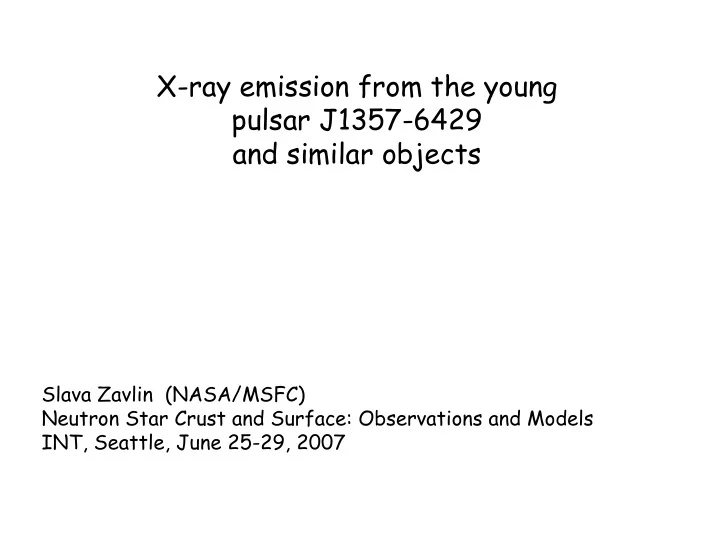

X-ray emission from the young pulsar J1357-6429 and similar objects Slava Zavlin (NASA/MSFC) Neutron Star Crust and Surface: Observations and Models INT, Seattle, June 25-29, 2007
Thermal vs. Nonthermal emission in pulsars of different ages Nonthermal (magnetospheric) emission, ~ dE/dt ~ t - β , β ~ 2—4 NSs cool down from T ≈ 10 11 K (at birth) to 0.2-2 MK in 0.1-1 Myr opt opt Young active (~1 kyr): Middle-aged (~100 kyr): Old (>1 Myr): nonthermal radiation thermal component from thermal emission from dominates; the whole surface; hot polar caps; Crab, B1509-58, B0656+14, B1055-15, millisecond PSRs, B0540-69 Geminga B0950+08
Nonthermally emitting pulsars: Crab τ ≈ τ c = P/[2dP/dt] = 1.3 kyr , dE/dt ≈ 5 × 10 38 ergs/s, d ≈ 2.0 kpc T ∞ < 2.1 MK (for R ∞ = 13 km, M=1.4 M sol — Tennant et al. 2001) J0205+6449 τ ≈ 0.8 kyr, τ c = 5.4 kyr , dE/dt ≈ 3 × 10 37 ergs/s, d ≈ 3.2 kpc T ∞ < 1.1 MK (Slane et al. 2004) Pulsars with dominating thermal X-ray flux: Vela (Pavlov et al. 2001) τ c = 11.0 kyr , dE/dt ≈ 7 × 10 36 ergs/s, d ≈ 0.3 kpc J1119-6127 (Gonzalez et al. 2005) τ c = 1.6 kyr , dE/dt ≈ 2 × 10 36 ergs/s, d ≈ 8.4 kpc
Multiwavelength spectrum of the Vela pulsar thermal nonthermal
PSR J1119-6127: XMM-Newton therm nontherm
PSR J1357-6429: τ c = 7.3 kyr , P = 166 ms , dE/dt ≈ 3 × 10 38 ergs/s, d ≈ 2.5 kpc (Camilo et al. 2004) τ = 2 τ c [n-1] -1 < 15 kyr (for n = 1 — 2 ), ∆ P/P = -2.4 × 10 -6 ⇒ ⇒ a young neutron star XMM-Newton EPIC: 12/15 ks (August 2005), spectral analysis Chandra HRC-I: 31 ks (November 2005), imaging & timing
PSR J1357-6429: Chandra HRC-I
PSR J1357-6429: Chandra HRC-I The elongated “tail” — a pulsar jet (?), like those generated by Crab, Vela, Geminga, PSRs B1757-24, B1957+20 (Weisskopf et al. 2000; Pavlov et al. 2003, 2006; Kaspi et al. 2001, Stappers et al. 2003)
PSR J1357-6429: Chandra HRC-I f p = 63 ± 15% Radio ephemeris valid for April-December 2005 (Camilo 2007) Signal detection: 99.8%
Spectrum of PSR J1357-6429: single PL model — Γ = 2.1 ± 0.4, L X = 2 × 10 32 ergs/s = 7 × 10 -5 dE/dt An additional thermal component — required at a 4.5 σ level
PSR J1357-6429: XMM-Newton EPIC-pn EPIC-MOS therm nontherm
NS atmosphere models: magnetized, B = 10 10 —10 13 G, nonmagnetic, B = 0
Angular dependence of radiation from a magnetized NS atmosphere: r B r r “pencil“-like structure along B “fan“-like structure at larger angles
NS atmosphere vs. blackbody model T bb / T atm ≈ 2-3 A atm / A bb ≈ 50-200
Two-component modeling of the X-ray spectrum of PSR J1357-6429: PL component — Γ = 1.2 ± 0.3, L X = 1 × 10 32 ergs/s = 5 × 10 -5 dE/dt Thermal component — blackbody spectrum: T ∞ = 1.7 ± 0.2 MK, R ∞ = 2.5 ± 0.5 km, L ∞ = 4 × 10 32 ergs/s NS magnetized atmosphere models: (Pavlov et al. 1995; Zavlin 2007) T = 1.0 ± 0.1 MK @ R = 10 km, L atm = 7 × 10 32 ergs/s T ∞ = [ 1 — 2GM/c 2 R] 1/2 T L ∞ = [ 1 — 2GM/c 2 R] L atm ≈ 0.5 L atm
Blackbody fitting results: radiation from small hot area (polar caps) on the NS surface? Problems: too large radius, R ∞ ≈ 2.5 km >> R pc = ( 2 π R 3 /cP) 1/2 = 0.3 km too large pulsed fraction, f p > 50 %, for isotropic emission NS atmosphere model results: radiation from the whole NS surface the large f p ⇒ nonuniform surface temperature ⇒ ⇒ a “mean” temperature of 1 MK
τ c / τ true T mean (NSA; R=10-12 km) T ∞ PSR R ∞ kyr MK MK km J1119-6127 1.6 1.6 2.4 3.4 J1357-6429 7.3 1.0 1.7 2.5 Vela 11.0 0.9 1.6 2.8 B1706-44 17.5 1.0 2.0 1.8 J0538+2817 620/30 1.1 2.1 1.7 B2334+61 40.9 0.9 1.5 2.8 putative PSR in IC443: CXU J0617..... 30-40? 0.8 1.4 2.4 (Kramer et al. 2003; McGowan et al. 2004; Zavlin 2007) J1119-6127: f p > 65 % (Gonzalez et al. 2005) J0538+2817: strong dependence of pulse profile on photon energy ⇒ (Zavlin & Pavlov 2004) anisotropic emission & nonuniform temperature ⇒
NS cooling models vs. observations Cooling curves with and without proton superfluidity (Yakovlev & Pethick 2004)
Conclusions: group of (at least) 6 young and pulsars with τ = 1—40 kyr with X-ray thermal flux dominating at softer energies even possessing strong magnetic fields , these are hot enough, > 1 MK, to have an atmosphere plausible interpretation involves NS atmosphere models, but requires inhomogeneous distributions of surface temperature (and magnetic field) more advanced analysis should include both spectral and pulse profile modeling (too many unknowns) Thermally emitting older pulsars, τ > 100 kyr, Geminga , PSRs B0656+14, B1055-52, radio-quiet NSs....: they are much colder , ~ 0.5 MK ⇒ atmospheres may not exist...
Recommend
More recommend